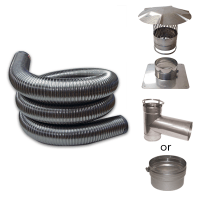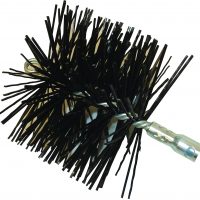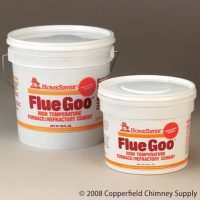Frequently Asked Questions
Q. Why do I need to insulate my chimney liner?
Q. How do I know what size diameter chimney liner I need?
Q. How do I know what length chimney liner I need?
Q. What is creosote?
Q. What if my chimney doesn’t have an old clay lining?
Q. How do you clean a stainless steel chimney liner?
Q. Do I need to install a chimney cap with my chimney liner?
Q. What is a chimney relining system?
Q. Do all chimneys have liners?
Q. What’s involved in getting a chimney liner replaced?
Q. How do I measure for a chimney liner tee kit?
Q. How do I measure for a fireplace insert kit?
Q. How do I know what size diameter pipe I need?
If you have further questions or would just like more information, please call us at 1-866-941-5112
Q. Why do I need to insulate my chimney liner?
Chimney liner insulation helps maintain the temperature of the inside of the liner. When the chimney liner stays warm the entire length up the chimney, there is less of a chance for condensation to occur. When condensation occurs in a chimney, combustion by-products can attach themselves to the condensation. The result – creosote. Creosote build-up is very flammable and is the leading cause of chimney fires. In order to maintain the Flex King UL listing, insulation is required for solid fuel applications. It is not required for gas or oil systems, though it is recommended.
Q. How do I know what size diameter chimney liner I need?
A general rule of thumb is to see what size outlet is on your stove or appliance. In most cases, fireplace inserts require 6 inch diameter chimney liner. Newer wood stoves generally require a 6″ chimney liner while older stoves may requires an 8″ diameter chimney liner.
In any situation you should first consult the manufacturers instructions of your appliance before installing a liner.
If you are installing a liner in an open fireplace chimney click here. If you are installing a liner for a gas or oil appliance, click here for a chimney liner diameter sizing chart.
Q. How do I know what length chimney liner I need?
The best way to size your chimney liner is by dropping a tape measure from the top of the chimney crown and measure the distance from that point to the thimble or opening where your appliance or stove will connect to the chimney. It’s always a good idea to add an extra foot or two just in case.
Q. What is creosote?
By definition creosote is a combustible deposit that originates from condensed wood smoke. It also includes tar, vapors, and other organic compounds. It’s a natural by-product of burning wood. Once inside the chimney, creosote usually under goes pyrolysis, a chemical alteration of the fuel molecules as a result of the application of heat.
The by-products of pyrolysis are gases and solid compounds. It takes on many different appearances. It can be sooty or ash like, sticky, tacky and runny tar glaze, dry honeycombs or curly flakes. It can also be dense, hard and shiny black tar glaze. Several variables that affect the amount of build-up deposited in the wood heating system are smoke density, flue gas temperature, and residence time.
The smokiest fires and the coolest chimneys produce the greatest amount of build-up. In addition over-sized equipment usually causes more build-up. Contrary to popular belief, burning seasoned hardwood does not eliminate build-up. Wood can actually be too dry.
Proper operation of the wood heating system is the single, most important contributing factor in minimizing build-up. Burning smaller fuel loads, refueling more frequently and avoiding slow, smoldering burns is also important.
Q. What if my chimney doesn’t have an old clay lining?
As long as you have a masonry chimney you can install a Chimney Liner. There doesn’t have to be an old clay lining in the chimney. If there isn’t a clay lining in the chimney then you definitely need to install a stainless steel liner.
Q. How do you clean a stainless steel chimney liner?
In order to clean your Chimney Liner you should use a poly brush. It has plastic bristles instead of metal.
Q. Do I need to install a chimney cap with my chimney liner?
To maintain the UL listing you should install a chimney cap. Chimney caps keep rain and other environmental elements out of your venting system. They also keep pests out of the chimney.
Q. What is a chimney relining system?
Most masonry chimneys are made with clay tiles that line the inside of the chimney. Over time these tiles can break down or crack due to several contributing factors. When this happens the chimney is no longer safe and needs a new liner. A stainless steel chimney liner is nothing more than a metal insert placed in the existing chimney. There are different types of metal liners, including flexible and rigid stainless steel. Depending on the design of your chimney a flexible liner may be your only option. If you have a short and straight ascending chimney you may opt for a rigid liner.
Q. Do all chimneys have liners?
No. Not all chimneys have liners. Chimneys built before 1940 most likely weren’t built with liners. If you have a chimney without a clay liner you can make it safe by installing a stainless steel liner.
Q. What’s involved in getting a chimney liner replaced?
The most cost effective way to replace your chimney liner is to have a stainless steel relining pipe installed. Depending on the type of chimney you have you may need either a rigid or flexible pipe.
Q. How do I measure for a chimney liner tee kit?
Measure from the top of the chimney down to the thimble area.
Q. How do I measure for a fireplace insert kit?
Measure from the top of the chimney to the middle of the fireplace box (where the logs burn).
Q. How do I know what size diameter pipe I need?
What size pipe is coming off the oil, gas furnace? If it’s 6” and it’s a gas or oil furnace, you need a 6” liner. However, you may be able to drop down to a 5” pipe if it is only one single appliance.
Please total the number of input BTU’s of all the appliances, most likely a furnace and a hot water heater, and refer to this chart to determine what size chimney liner you need. Be sure to make sure you read the correct chart, the “SINGLE” or “MULTIPLE” appliance chart.
In all cases, consult the documentation that came with your furnace and burner, or the manufacturer. You will be able to determine the minimum diameter liner you can install. If you cannot find your documentation, manufacturer’s websites will generally have the documentation available online.
For wood- If 6″ is coming off the stove (normally 6”) go with a 6” liner. For some applications, a 5.5″ chimney liner can be acceptable. However, if it’s 8” and the flue size will allow for an 8” liner you can use 8″ pipe. Never downsize an 8″ stove pipe to 6″.






